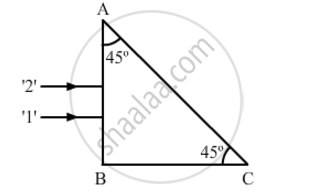Advertisements
Advertisements
Question
Obtain the conditions for the bright and dark fringes in diffraction pattern due to a single narrow slit illuminated by a monochromatic source.
Explain clearly why the secondary maxima go on becoming weaker with increasing.
Solution

Consider a point P on the screen at which wavelets travelling in a direction making angle θ with CO are brought to focus by the lens. The wavelets from points A and B will have a path difference equal to BN.
From the right-angled ΔANB, we have
BN = AB sinθ
BN = a sinθ …(1)
Suppose BN = λ and θ = θ1
Then, the above equation gives
λ = a sin θ1
`sin theta_1 = lambda/a ........ (2)`
Such a point on the screen will be the position of first secondary minimum.
If BN = 2λ and θ= θ2, then
2λ = a sin θ2
`sin theta_2 = (2lambda)/a .......... (3)`
Such a point on the screen will be the position of second secondary minimum. In general, for nth minimum at point P,
`sintheta_n = (nlambda)/a ........ (4)`
If yn is the distance of the nth minimum from the centre of the screen, then from right-angled ΔCOP, we have
`tantheta_n =(OP)/(CO)=y_n/D .............. (5)`
In case θn is small, sin θn ≈ tan θn
∴ Equations (iv) and (v) give
`(y_n)/D = (nlambda)/a`
`y_n = (nlambdaD)/a`
If `BN = (3lambda)/2`and θ = θ1′, then from equation (i), we have
`sintheta_1^' = (3lambda)/(2a)`
Such a point on the screen will be the position of the first secondary maximum. Corresponding to path difference,
`BN =(5lambda)/2`and θ = θ ′2, the second secondary maximum is produced
In general, for the nth maximum at point P,
`sintheta_n^' = ((2n+1)lambda)/(2a) .............. (6)`
If is the distance of nth maximum from the centre of the screen, then the angular position of the nth maximum is given by,
`tantheta_n^' = (y_n)/a ....... (7)`
In case θ′n is small,
sin θ’n ≈ tan θ’n
`y_n^' = ((2n+1)lambdaD)/(2a)`
For n = 1,
`theta' = (3lambda)/(2a)`(From eq(6), small angle approximation, `sin theta' =theta' = ((2n+1)lambda)/(2a)`
This angle is midway between two of the dark fringes. Divide the slit into three equal parts. If we take the first two third part of the slit the path difference between the two ends would be,
`2/3 a xx theta' = lambda`
The first two third is divided into two halves which have path difference `lambda/2`. The contribution due to these two halves is 180° out of phase and gets cancel. Only the remaining one third part of the slit contributes to the intensity at a point between the two minima which will be much weaker than the central maxima. Thus with increasing n the intensity of maxima gets weaker.
RELATED QUESTIONS
Two monochromatic rays of light are incident normally on the face AB of an isosceles right-angled prism ABC. The refractive indices of the glass prism for the two rays '1' and '2' are respectively 1.3 and 1.5. Trace the path of these rays after entering the prism.

State the essential conditions for diffraction of light ?
Monochromatic light of frequency 5.0 × 1014 Hz is produced by a laser. The power emitted is 3.0 × 10–3 W. Estimate the number of photons emitted per second on an average by the source ?
Which of the following sources provides the best monochromatic light?
State with reason, how the linear width of the central maximum will be affected if
(i) monochromatic yellow light is replaced with red light, and
(ii) distance between the slit and the screen is increased.
Find the angle of incidence at which a ray of monochromatic light should be incident on the first surface AB of a regular glass prism ABC so that the emergent ray grazes the adjacent surface AC. (Refractive Index of glass = 1 .56)
For constructive interference to take place between two monochromatic light waves of wavelength λ, the path difference should be ______.
Monochromatic light of wavelength 600 nm is incident from the air on a water surface. The refractive index of water is 1.33. Find the
- wavelength,
- frequency and
- speed, of reflected and refracted light.
Monochromatic light of wavelength 396 nm is incident on the surface of a metal whose work function is 1.125 eV. Calculate:
- the energy of an incident photon in eV.
- the maximum kinetic energy of photoelectrons in eV.
The Figure below shows a ray of monochromatic light LM incident on the first surface AB of a regular (equilateral) glass prism ABC. The emergent ray grazes the adjacent surface AC. Calculate the angle of incidence. (Refractive Index of glass = 1.5)

